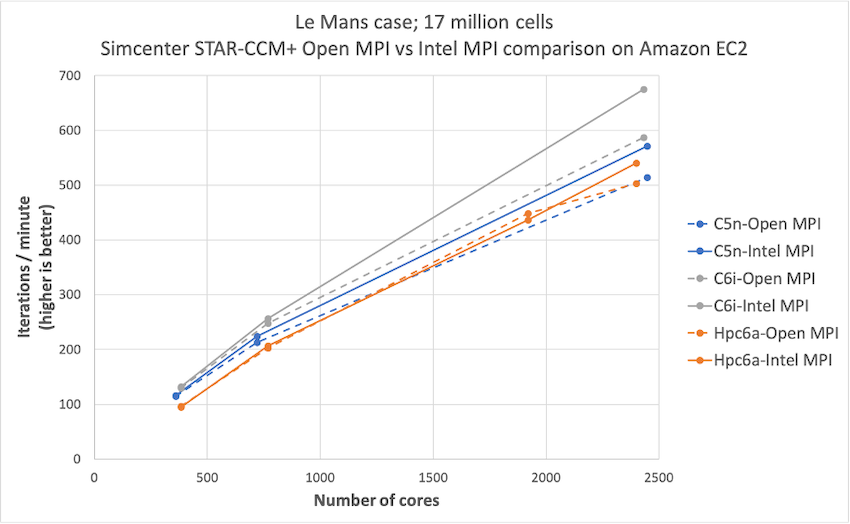AWS HPC Blog
Category: Amazon EC2
Application deep-dive into the AWS Graviton3E-based Amazon EC2 Hpc7g instance
In this post we’ll show you application performance and scaling results from Hpc7g, a new instance powered by AWS Graviton3E across a wide range of HPC workloads and disciplines.
Cost-effective and accurate genomics analysis with Sentieon on AWS
In this blog post, we benchmark the performance of Sentieon’s DNAseq and DNAscope pipelines using publicly available genomics datasets on AWS. You will gain an understanding of the runtime, cost, and accuracy performance of these germline variant calling pipelines across a wide range of Amazon EC2 instances.
Simcenter STAR-CCM+ price-performance on AWS
Organizations such as Amazon Prime Air and Joby Aviation use Simcenter STAR-CCM+ for running CFD simulations on AWS so they can reduce product manufacturing cycles and achieve faster times to market. In this post today, we describe the performance and price analysis of running Computational Fluid Dynamics (CFD) simulations using Siemens SimcenterTM STAR-CCM+TM software on AWS HPC clusters.
GROMACS performance on Amazon EC2 with Intel Ice Lake processors
We recently launched two new Amazon EC2 instance families based on Intel’s Ice Lake – the C6i and M6i. These instances provide higher core counts and take advantage of generational performance improvements on Intel’s Xeon scalable processor family architectures. In this post we show how GROMACS performs on these new instance families. We use similar methodologies as for previous posts where we characterized price-performance for CPU-only and GPU instances (Part 1, Part 2, Part 3), providing instance recommendations for different workload sizes.
Coming soon: dedicated HPC instances and hybrid functionality
This year, we’ve launched a lot of new capabilities for HPC customers, making AWS the best place for the length and breadth of their workflows. EFA went mainstream and is now available in sixteen instance families for fast fabric capabilities for scaling MPI and NCCL codes. We’ve written deep-dive studies to explore and explain the optimizations that will drive your workloads faster in the cloud than elsewhere. We released a major new version of AWS ParallelCluster with its own API for controlling the cluster lifecycle. AWS Batch became deeply integrated into AWS Step Functions and now supports fair-share scheduling, with multiple levers to control the experience. Today we’re signaling the arrival of a new HPC-dedicated instance family – the Hpc6a – and an enhanced EnginFrame that will bring the best of the cloud and on-premises together in a single interface.
EFA is now mainstream, and that’s a Good Thing
We have recently launched three new Amazon EC2 instances types enabled with Elastic Fabric Adapter (EFA), our network interface for Amazon EC2 instances that enables customers to run applications requiring high levels of inter-node communications at scale on AWS. These bring our EFA-enabled count to sixteen different instance families covering a wide range of use cases. EFA is going mainstream and we are just getting started.
Scaling a read-intensive, low-latency file system to 10M+ IOPs
Many shared file systems are used in supporting read-intensive applications, like financial backtesting. These applications typically exploit copies of datasets whose authoritative copy resides somewhere else. For small datasets, in-memory databases and caching techniques can yield impressive results. However, low latency flash-based scalable shared file systems can provide both massive IOPs and bandwidth. They’re also easy to adopt because of their use of a file-level abstraction. In this post, I’ll share how to easily create and scale a shared, distributed POSIX compatible file system that performs at local NVMe speeds for files opened read-only.
Running GROMACS on GPU instances: multi-node price-performance
This three-part series of posts cover the price performance characteristics of running GROMACS on Amazon Elastic Compute Cloud (Amazon EC2) GPU instances. Part 1 covered some background no GROMACS and how it utilizes GPUs for acceleration. Part 2 covered the price performance of GROMACS on a particular GPU instance family running on a single instance. […]
Running GROMACS on GPU instances: single-node price-performance
This three-part series of posts cover the price performance characteristics of running GROMACS on Amazon Elastic Compute Cloud (Amazon EC2) GPU instances. Part 1 covered some background no GROMACS and how it utilizes GPUs for acceleration. This post (Part 2) covers the price performance of GROMACS on a particular GPU instance family running on a […]
Running GROMACS on GPU instances
Comparing the performance of real applications across different Amazon Elastic Compute Cloud (Amazon EC2) instance types is the best way we’ve found for finding optimal configurations for HPC applications here at AWS. Previously, we wrote about price-performance optimizations for GROMACS that showed how the GROMACS molecular dynamics simulation runs on single instances, and how it […]








